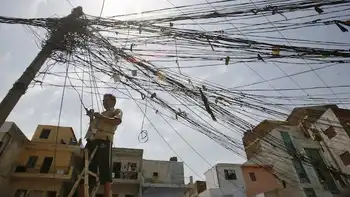Homespun power from wind
In the decade that followed, the wind drove Ms. Wilson Jones crazy from November through April, she said, whipping across her yard and making it difficult to work in the garden. At times, it was hard to walk outside.
Eventually, the couple decided to capitalize on their affliction. Last summer, they installed a 56-foot wind turbine in their yard to draw electrical power from the wind, which sometimes gets up to 40 miles per hour. They did the work themselves over a weekend, digging a four-foot-deep hole for the foundation and raising the $13,000 turbine with a winch on their Jeep. It was spinning by early September, and their electricity bills dropped sharply, from $90 to $10 for November, one of the windier months.
“Now, the faster the wind goes, the happier I am,” said Ms. Wilson Jones, a director of nursing at Community Blood Services of Illinois.
Until recently, wind turbines were used primarily by those who lived outside the range of local utility lines, or who wanted to live completely off the grid. Now, reductions in their size and cost, along with improvements in their efficiency, are allowing suburban homeowners with no dissident leanings to speak of to install them in growing numbers, with concerns over rising energy costs and global warming driving the demand.
Sales of wind turbines have been growing steadily since 1990, when the American Wind Energy Association, a nonprofit advocacy group in Washington, D.C., began tracking them. Last year, about 7,000 small wind turbines — defined as those that have a capacity of up to 100 kilowatts, roughly enough to power a large school — were purchased in the United States, according to the group, which said it expects sales to reach about 10,000 this year.
Residential turbines, which account for half those sales, are typically 33 to 100 feet tall, with outputs of two to 10 kilowatts. They cost between $12,000 and $55,000, but in recent years, 19 states, including California, New Jersey, New York, Massachusetts and Ohio, have begun offering incentives and rebates that can cut purchase prices by up to 50 percent. And just recently, the United States House of Representatives passed a bill that would help states provide grants and low-interest loans for residential turbines (as well as solar panels and geothermal heat pumps), and that would offer a 30 percent federal tax credit on turbine purchases, up to $4,000; the Senate is now considering a similar measure.
A 10-kilowatt turbine in an area with an average wind speed of 12 miles per hour can lead to a reduction in carbon dioxide emissions equivalent to removing 1.3 cars from the road, according to the wind energy association. But for some, the financial savings made possible by turbines are at least as important.
Marc Schambers eliminated his payments to Southern California Edison after he installed a turbine in his backyard in the town of Phelan five years ago. Mr. Schambers, the owner of CleanMessage, a spam-filtering service, opted for an unusually tall 120-foot model (taller devices generate more energy) because his electricity bills were as much as $1,000 a month in summer, he said, when he was paying to cool both his home office and his 1,800-square-foot house.
He has since paid off his $25,000 investment — the turbine cost $46,000, but he received a $21,000 rebate from the California Energy Commission — and now produces more power than he can use. Since California is one of 23 states that require power companies to offer “net metering,” by which customers receive credit for any extra power they generate, he comes out ahead.
“One of the top 10 pleasures in life is watching your electrical meter go backward,” he said.
Mr. SchambersÂ’s neighbors apparently agree; he said he can see 20 turbines from his backyard.
Other parts of the country, too, offer ideal conditions for turbines: The Great Plains, for example, are the “Saudi Arabia of wind,” according to Karl Bergey, the chairman and chief executive of Bergey Windpower, a turbine manufacturer in Norman, Okla.
Some consumers have installed turbines in low-wind areas. In August, Curt and Christine Mann put up a turbine next to their Craftsman-style house in the Grant Park neighborhood of Atlanta, despite an average wind speed of only nine miles per hour, the minimum recommended by the wind energy association. (The group also says that home turbines should be at least 30 feet tall and surrounded by at least an acre of land, free of any large obstructions like dense trees.)
So far, their turbine has led to only a modest reduction in electricity costs, from around $95 to roughly $75 a month, and it could take up to 20 years at that rate to recoup their initial investment. But they were more interested in ecological benefits than financial ones, said Mr. Mann, a real estate developer whose company is called City Crest Holdings.
Local governments have put up roadblocks to the devices. A few towns, like Blowing Rock, N.C., have banned them outright because of their appearance, and others require homeowners to petition the local zoning board for a variance to exceed building height limits. Some cities require letters of support from neighbors, which can be hard to obtain because some people believe turbines may threaten birds, reduce property values and make too much noise.
At Altamont Pass Wind Resource Area in California, it is estimated that between 1,700 to 4,700 birds are killed each year. But Michael Daulton, director of conservation policy for the National Audubon Society, said it is not clear what effect individual wind turbines have on birds. The society suggests that homeowners learn whether they live close to a wildlife preserve that attracts a lot of birds, or are situated on a bird migratory route, as the Altamont wind farm is.
TurbinesÂ’ effects on property values is not clear. Ryan Wiser, a staff scientist at the Lawrence Berkeley National Laboratory, said the effect of large wind farms on home values has been mixed, and added that there are no studies covering small turbines. When calculating the sale price of a home with a turbine, some brokers value them as they would a swimming pool, adding half of the purchase and installation costs to a homeÂ’s price.
The noise and shadows turbines make have resulted in some concerns. In July, residents of Beach Haven Terrace, N.J., sued a neighbor, saying that the noise from his 35-foot turbine exceeded 50 decibels (the sound level of light traffic or an average home), and that it cast “strobe-like shadows” on their property for several hours a day.
When Kurt Karpavich, a resident of Watertown, Conn., an affluent rural town in Litchfield County, sought a variance from the town to put up a 55-foot turbine behind his house last summer, a dozen neighbors signed a petition against it and placed signs reading “No to the Windmill” on their lawns.
Jacqueline and David Daddona, who live next to Mr. Karpavich, are concerned that his turbine will cast shadows on their house, attract lightning and mar their view of the Naugatuck Valley. Others objected to the presence of a tower rising above the roofline.
“I’m not against the environment, but I just think there’s a place for all this,” said Mr. Daddona. “You shouldn’t try to save a little bit on your electrical bill if it affects your neighbors.”
Mr. Karpavich was granted the variance in early summer, but the Daddonas appealed the decision and sued the town planning and zoning appeals commission as well as Mr. Karpavich. The various parties have a January date to meet in Watertown Superior Court. Mr. Karpavich hopes the legal wrangling is done by this winter so he can install the turbine — the town’s first — in the spring.
“It’s been a tough fight,” said Mr. Karpavich. “But it’s more of a crusade now.”
Related News

More Managers Charged For Price Fixing At Ukraine Power Producer
KIEV - Two more executives of DTEK, Ukraine’s largest private power and coal producer, have been charged in a criminal case on August 14 involving an alleged conspiracy to fix electricity prices with the state energy regulator, Interfax reported.
They are Ivan Helyukh, the CEO of subsidiary DTEK Grid, and Borys Lisoviy, a top manager of power generation company Skhidenergo, according to Kyiv-based Concorde Capital investment bank.
Ukraine’s Anti-Corruption Bureau (NABU) alleges that now four DTEK managers “pressured” and colluded with four regulators at the National Energy and Utilities Regulatory Commission to manipulate tariffs on electricity generated from coal that forced consumers…





